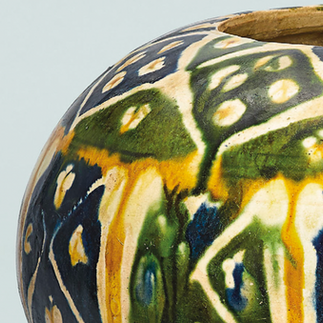唐三彩的多元面貌
经历十载搜集而成的「德馨书屋珍藏」让我们重新认识唐三彩的艺术和实用价值
佳士得香港將於2016年10月4日舉行「古今 | 佳士得」拍賣,呈獻不同類別的中國藝術品,其中亮點有台灣資深藏家經歷數十載所蒐集而成的「德馨書屋珍藏」,藏品包括一系列造型別緻、釉色獨特的唐三彩器。
這些精緻收藏讓我們得知唐三彩並不局限於三種顏色,墓葬明器亦並非其唯一用途,藉此更重新認識唐三彩的藝術和實用價值。
Highlights of The Pavilion Sale in October 2016 at Christie’s Hong Kong included the Dexinshuwu Collection, comprising exceptional sancai pieces from the Tang dynasty (618-907). With their sophisticated shapes and vibrant glazes, these pieces, which were collected over decades, showcase the mostly brown, green and amber palette of sancai and the versatility of these wares beyond their original design for use as mortuary objects.
唐 三彩貼花三足罐 成交价 港元 275,000 估价:港元 100,000 – 港元 150,000 (2016年10月4日)
唐三彩被喻為唐朝藝術的代表,以黃、白、綠的色釉為主,故而被稱為「唐三彩」。事實上,除了普遍的「三彩」之外,不少唐三彩的器身均色彩斑斕。
「古今 | 佳士得」拍賣呈獻的「德馨書屋珍藏」中,便有數件工藝精美、顏色富麗的唐三彩器,如飾以綠、琥珀和淺黃色釉的唐三彩貼花三足罐。
唐三彩燒製技巧繁複,須以高溫燒製,部分釉彩更要放入窯內進行二次燒製才能達致效果,加入鈷料以致產生藍斑效果的作品更是稀有瑰寶。鈷藍料為波斯進口的珍貴顏料,因此飾以鈷藍釉料的瓷器多為達官貴人家中的裝飾品,是一種身份地位的象徵。
The pinnacle of Tang-dynasty art
Beyond the yellow, white and green hues associated with the ceramics produced in this period, sancai-glazed pieces come in many colourful variations. The Dexinshuwu Collection featured a selection of exquisitely crafted, richly coloured sancai-glazed pieces, including an applique-decorated tripod jar finished with green, amber and ivory glazes (above).
唐 三彩幾何紋罐 成交价:港元 125,000 估价:港元 150,000 – 港元 260,000
唐 三彩藍斑奩爐 成交价:港元 237,500 估价:港元 100,000 – 港元 200,000
唐代國力強盛,對不同種族和宗教格外包容,造就多元化的文化背景,而外來文化在某程度上亦為唐代的審美風尚帶來正面影響,「德馨書屋珍藏」中的唐三彩長頸瓶及唐三彩幾何紋長頸瓶可謂佳例,印證了當時頻繁的中外文化交流。長頸瓶的設計有別於一般唐三彩器,相信是受外來文化所啟發設計,其做工不但精細,瓶身的幾何圖案更富創意,充分展現變化多端的紋飾技巧。
The significance of cobalt blue
The production of a sancai piece, which had to be glazed and fired at high temperature, involved numerous meticulous steps. Some glazes had to be re-fired to achieve the ideal appearance, with cobalt blue-glazed wares particularly rare because the pigment was a precious material imported from Persia. As such, pieces with cobalt-blue glazes were symbols of wealth and status, and were usually found only in the homes of royal families and aristocrats. A large sancai-glazed jar (above) and a blue-splashed sancai-glazed cylindrical tripod censer (below) are among the sale’s highlights.
A glimpse into history
Known for its military strength and openness towards other races and religions, the Tang dynasty developed a culture of rich diversity. To some extent, foreign influence had a positive impact on the aesthetics of the period. Fine examples of this dynamic exchange include the sancai-glazed bottle vase and the sancai-glazed vase below, both from the Dexinshuwu Collection.
唐 三彩幾何紋長頸瓶 成交价:港元 437,500 估价:港元 100,000 – 港元 180,000
唐 三彩長頸瓶
唐 三彩手爐 成交价:港元 1,000,000 估价:港元 150,000 – 港元 200,000
唐三彩被視為唐代文化藝術的成就,在中國陶瓷史上擁有特殊地位。因外觀斑斕華麗,無論在造型、裝飾、色釉和燒製工藝上均呈現中國製瓷的非凡技藝。是次「古今 | 佳士得」拍賣呈獻的一系列唐三彩器更反映當時的社會習俗和文化特色,其種類和款式之廣,讓藏家得以多角度認識唐三彩鮮為人知的一面。
Sancai-glazed pieces enjoy a unique status in the long history of Chinese ceramics. From their captivating colours to the meticulous craftsmanship they embody, these stunning objects offer a window onto the customs and culture of ancient times, and new perspectives on the concept of beauty itself.






















1 million HKD for the Sancai incense burner back in 2016, very impressive buy.